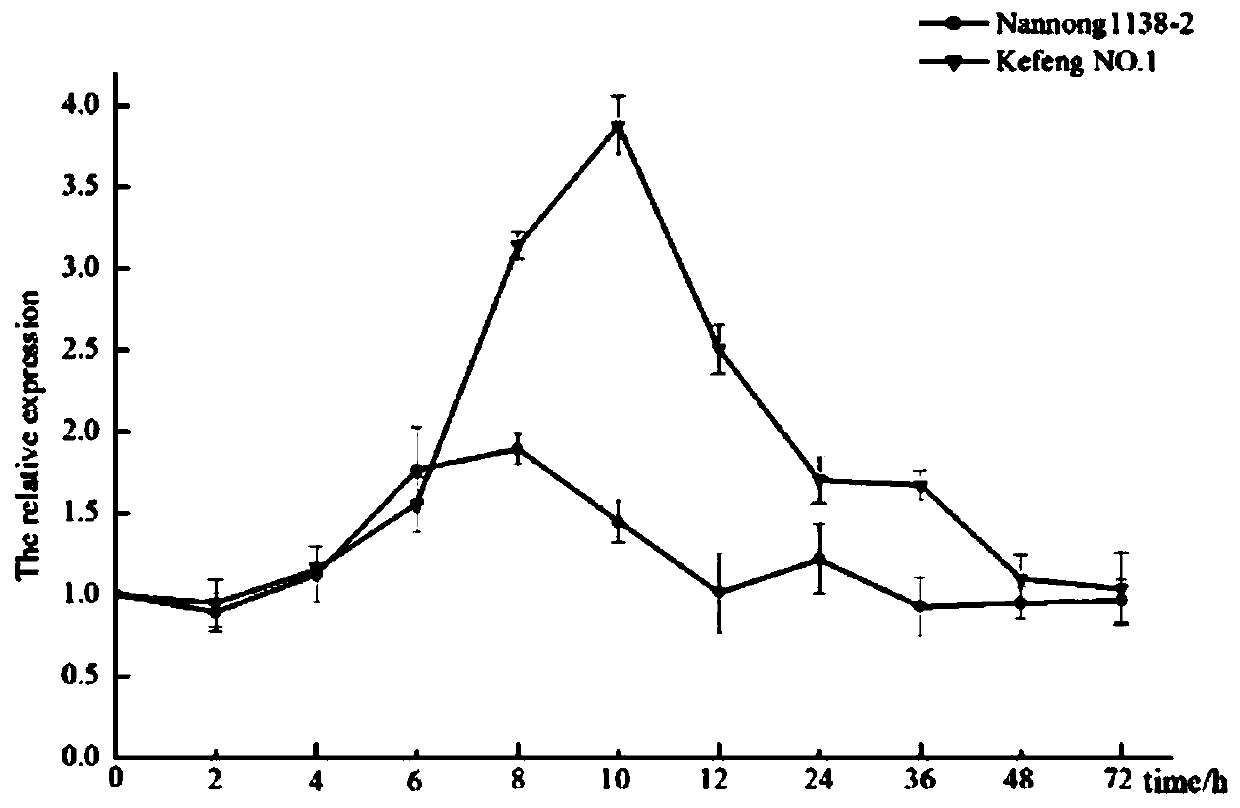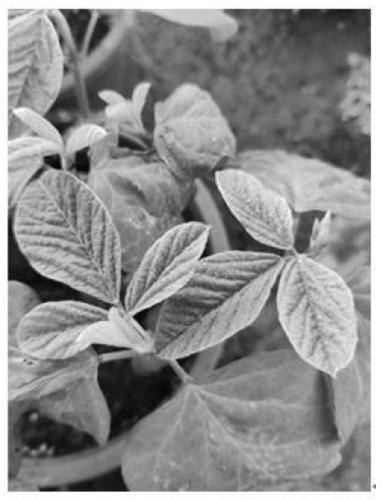Soybean mosaic virus SC18 line resistance gene GmNIK and application thereof
A soybean mosaic virus, SC18 technology, applied in application, genetic engineering, plant genetic improvement and other directions, can solve problems such as top withering, necrosis, leaf shrinkage, etc.
- Summary
- Abstract
- Description
- Claims
- Application Information
AI Technical Summary
Problems solved by technology
Method used
Image
Examples
Embodiment 1
[0023] Embodiment 1: Obtaining of GmNIK gene
[0024] 1. RNA extraction:
[0025] (1) Take 50-100 mg of soybean leaf tissue and grind it in liquid nitrogen, add 1 ml Trizol to fully homogenize it, and let it stand at room temperature for 5 minutes.
[0026] (2) Add 0.2ml of chloroform, shake for 15s, and let stand for 2min.
[0027] (3) Centrifuge at 4°C, 12000g×15min, and take the supernatant.
[0028] (4) Add 0.5ml of isopropanol, mix the liquid in the tube gently, and let stand at room temperature for 10 minutes.
[0029] (5) Centrifuge at 4°C, 12000g×10min, discard the supernatant.
[0030] (6) Add 1ml of 75% ethanol to gently wash the precipitate. 4°C, 7500g×5min, discard the supernatant.
[0031] (7) Dry it and add an appropriate amount of DEPC H2O to dissolve (65°C for 10-15 minutes). Extracted RNA should be stored at -80°C.
[0032] 2. Synthesis of cDNA:
[0033] (1) Take the RNA (≤2 μg) stored at -80°C and dissolve it on ice. Configure the following reaction ...
Embodiment 2
[0052] Example 2: Analysis of the induced expression of GmNIK by SC18
[0053] The susceptible variety Nannong 1138-2 and the resistant variety Kefeng No.1 were planted, and SC18 was inoculated when the first true leaf unfolded, and phosphate buffered solution PBS was inoculated at the same time as the control. The leaves of inoculation 0h, 2h, 4h, 6h, 8h, 10h, 12h, 24h, 36h, 48h, 72h were collected, and qRT-PCR was performed. See Example 4 for quantitative primers. Induced expression analysis results such as figure 1As shown, the expression levels of GmNIK in Kefeng 1 and Nannong 1138 were up-regulated after inoculation with SC18. Up-regulated to the highest, but the peak expression of Kefeng 1 is much higher than that of Nannong 1138-2. It indicated that the high expression of GmNIK in the disease-resistant variety may be the reason for its resistance to SC18.
Embodiment 3
[0054] Embodiment 3: Construction of GmNIK silencing vector
[0055] 1. Use Primer5.0 software to design specific silent fragment primers: upstream primer F3: 5'-GAATCCTCTGCATGAGGATCCGATAAATGCAAAAACATTCAAT-3' (SEQ ID NO.5), downstream primer F4: 5'-CTCTCGAGGCCTGGAGTCGACGAAACCAAGTCCCAGAATTAG-3' (SEQ ID NO. 6), using the constructed vector pMD20-T-NIK (constructed in Example 1) as a template to amplify the silent fragment.
[0056] The reaction system is:
[0057]
[0058] The reaction conditions were 95°C for 2min; 95°C for 10s, 58°C for 10s, 72°C for 1min, 32 cycles; 72°C for 1min. The amplified product was purified and recovered and stored at -80°C.
[0059] The BPMV silencing vector pBPMV-IA-V2 was digested with restriction enzymes BamH I and SalI at 37°C for 3 hours, purified and recovered. The silent fragment was connected to pBPMV-IA-V2 by homologous recombination,
[0060] The reaction system is:
[0061]
[0062]
[0063] The reaction conditions were 37°C ...
PUM
 Login to View More
Login to View More Abstract
Description
Claims
Application Information
 Login to View More
Login to View More - R&D
- Intellectual Property
- Life Sciences
- Materials
- Tech Scout
- Unparalleled Data Quality
- Higher Quality Content
- 60% Fewer Hallucinations
Browse by: Latest US Patents, China's latest patents, Technical Efficacy Thesaurus, Application Domain, Technology Topic, Popular Technical Reports.
© 2025 PatSnap. All rights reserved.Legal|Privacy policy|Modern Slavery Act Transparency Statement|Sitemap|About US| Contact US: help@patsnap.com



